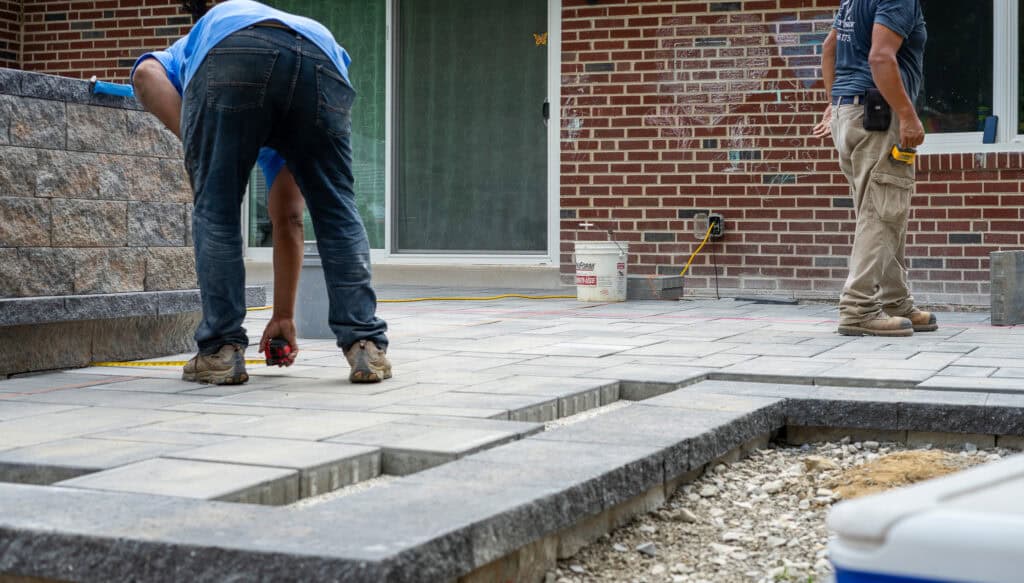Walkways are more than just functional paths—they enhance curb appeal and provide safe passage around your property. However, constant exposure to the elements, foot traffic, and natural wear and tear can lead to cracks, uneven surfaces, and costly repairs. Regular maintenance can help you extend the life of your walkway while preserving its beauty and safety.
In this guide, we’ll explore essential maintenance tips to prevent walkway damage, ensure longevity, and keep your outdoor living space looking its best. Whether you have a concrete, brick, or stone walkway, following these steps can help you avoid expensive masonry repair and keep your custom walkway in excellent condition.

Keep It Clean: The First Step to Long-Lasting Walkways
A well-maintained walkway starts with regular cleaning. Over time, dirt, leaves, and debris accumulate on your walkway’s surface, leading to stains and even structural damage if left unchecked. Moss and algae can also grow in damp areas, making your walkway slippery and unsafe. By implementing a consistent cleaning routine, you can preserve your walkway’s integrity and appearance.
Sweeping your walkway weekly prevents debris build-up that can lead to staining and water retention. A stiff-bristle broom is effective for removing loose dirt, while a leaf blower can help with seasonal debris. If left unattended, accumulated dirt can mix with moisture and form stubborn grime that may require professional cleaning.
For deeper cleaning, pressure washing is an effective method to restore the original look of your walkway. However, different materials require different pressure settings—concrete walkways can handle higher pressure, while brick and stone require a gentler approach to prevent surface damage. Using an eco-friendly cleaner can further help in removing oil stains, mold, and mildew without harming the surrounding landscape.
In addition to washing, consider applying a mild detergent solution for tougher stains. Scrubbing with a brush can break down stains without the need for harsh chemicals. Avoid using acidic cleaners on masonry surfaces, as they can erode the material and lead to further walkway damage.
By making walkway cleaning a routine part of your outdoor living space maintenance, you can prevent long-term deterioration and enhance the beauty of your home. Keeping your walkways free from dirt and stains ensures they remain safe, attractive, and durable for years to come.
Seal the Deal: Protect Your Walkway with Sealant
Applying a sealant is one of the best ways to protect your walkway from the elements. Over time, rain, snow, and UV rays can weaken your walkway’s surface, leading to cracks and discoloration. A high-quality sealant acts as a protective barrier, preventing water penetration and reducing the risk of damage.
Concrete walkways benefit greatly from sealing, as it helps to prevent cracking and chipping. When water seeps into the surface and freezes, it expands, leading to cracks. Sealing your walkway reduces this risk and ensures a longer lifespan. Typically, a concrete walkway should be sealed every two to three years to maintain its durability.
For paver walkways, sealing helps lock in the sand between the joints, preventing weed growth and shifting over time. Additionally, a good sealant enhances the color and texture of the pavers, making your custom walkway stand out. Before applying a sealant, ensure the walkway is clean and completely dry to achieve the best results.
Stone walkways, especially those made from porous materials like limestone or flagstone, require sealing to prevent moisture absorption. Without a sealant, these materials can erode over time, leading to surface flaking and deterioration. Choosing a breathable, water-based sealant allows moisture to escape while protecting against stains and damage.
Regular sealing not only improves the longevity of your walkway but also enhances its appearance. By investing in this simple maintenance step, you can save yourself the hassle of frequent walkway repair while keeping your outdoor living space looking pristine.

Stop the Spread: Fixing Small Cracks Before They Worsen
Cracks in your walkway may seem minor at first, but if left untreated, they can grow into major structural issues. Water, foot traffic, and temperature fluctuations can cause these cracks to expand, making repairs more complicated and costly. Addressing small cracks early is a proactive way to avoid expensive masonry repair down the road.
Start by assessing the extent of the damage. Hairline cracks can often be filled with a concrete patch or polymer-based sealant, preventing water from seeping in and worsening the problem. However, larger cracks may require more extensive repairs, including resurfacing or replacing individual pavers.
Cleaning the crack before applying a filler ensures better adhesion. Use a wire brush to remove dirt and debris, then apply a crack filler suited for your walkway’s material. For concrete, a flexible caulk works well, while epoxy-based fillers are ideal for stone and brick walkways.
Temperature changes can cause cracks to expand and contract, so it’s best to complete repairs during mild weather. Extreme heat can cause fillers to dry too quickly, while cold temperatures may prevent proper bonding. Sealing the repaired area afterward adds an extra layer of protection against future damage.
By addressing cracks promptly, you can maintain the integrity of your walkway and avoid costly replacements. Regular inspections and timely repairs ensure your custom walkway remains safe and functional for years to come.
Managing Water Drainage Around Your Walkway
Proper water drainage is crucial in preserving the integrity of your walkway. When water pools or flows incorrectly, it can erode the soil beneath your walkway, causing uneven surfaces, cracks, and even structural damage. Managing drainage effectively prevents costly walkway repair and enhances the longevity of your outdoor living space.
One way to improve drainage is by ensuring your walkway is slightly sloped to direct water away from the foundation and toward a designated drainage area. A well-designed slope helps prevent water from accumulating on the surface, reducing the risk of erosion and slip hazards.
Installing a drainage system, such as French drains or gravel channels along the edges of your walkway, can also help redirect excess water. These solutions prevent water from pooling underneath and weakening the base of your walkway, which can lead to shifting and sinking over time.
Another effective strategy is incorporating permeable materials, such as porous pavers or gravel, into your walkway design. These materials allow water to pass through rather than collect on the surface, minimizing the risk of damage. Regularly checking and clearing drainage paths ensures proper water flow and prevents blockages.
By managing water drainage effectively, you can protect your custom walkway from premature deterioration, maintaining both its functionality and visual appeal for years to come.

Avoiding Heavy Loads and Impact Damage
Walkways are designed to handle foot traffic, but excessive weight or impact can lead to cracks, sinking, and surface damage. Taking preventative measures can help preserve your walkway’s strength and prevent unnecessary masonry repairs.
One of the main causes of damage is placing heavy objects, such as parked vehicles, large planters, or heavy furniture, on your walkway. Over time, these excessive loads can weaken the structure, leading to cracks and uneven surfaces. If you must place heavy items on your walkway, consider using protective pads or distributing the weight evenly.
Avoiding sudden impact is also essential in maintaining your walkway’s durability. Dropping heavy objects or using high-impact tools, such as hammers or metal shovels, can cause chips and fractures in the surface. Instead, use soft-bristled brooms or rubber-edged tools for cleaning and maintenance.
Tree roots and shifting ground can also contribute to walkway instability. Regularly inspect your walkway for signs of movement or pressure points and take action before the damage worsens. Installing root barriers or reinforcing the foundation with compacted gravel can prevent future issues.
By being mindful of heavy loads and impact damage, you can extend the lifespan of your walkway and maintain a smooth, safe surface for everyday use.
FAQ: Common Questions About Walkway Repair & Maintenance
How often should I seal my walkway?
It depends on the material, but generally, every two to three years is recommended for concrete, while pavers and natural stone may require sealing annually.
What causes walkway cracks?
Cracks can be caused by water damage, freezing and thawing cycles, poor installation, tree roots, and heavy loads. Addressing these issues early can prevent further damage.
Can I repair a walkway myself, or should I hire a professional?
Small cracks and minor damage can be repaired with DIY methods, but extensive damage or structural issues often require professional masonry repair.
What is the best way to remove stains from my walkway?
Pressure washing, mild detergents, and stain-specific cleaners work well. Avoid using harsh chemicals that may damage the surface.
How do I prevent weeds from growing between pavers?
Using polymeric sand between pavers, sealing the walkway, and regular maintenance can help prevent weed growth and shifting.

Professional Help for Long-Lasting Walkways
Maintaining your walkway doesn’t have to be overwhelming, but regular upkeep is essential for preserving its durability and appearance. From cleaning and sealing to repairing small cracks before they spread, these simple maintenance steps can prevent costly walkway repairs in the future. By implementing these strategies, you can ensure your custom walkway remains a beautiful and functional part of your outdoor living space.
If your walkway needs professional repair, Kelly Masonry is here to help. With expert craftsmanship and years of experience in masonry repair, their team specializes in restoring and maintaining walkways to their original beauty. Whether you need minor repairs or a complete restoration, they offer top-quality services to keep your property looking its best.
For reliable walkway repair and maintenance, visit Kelly Masonry Walkway Repair Services and get in touch with their experienced professionals today!
